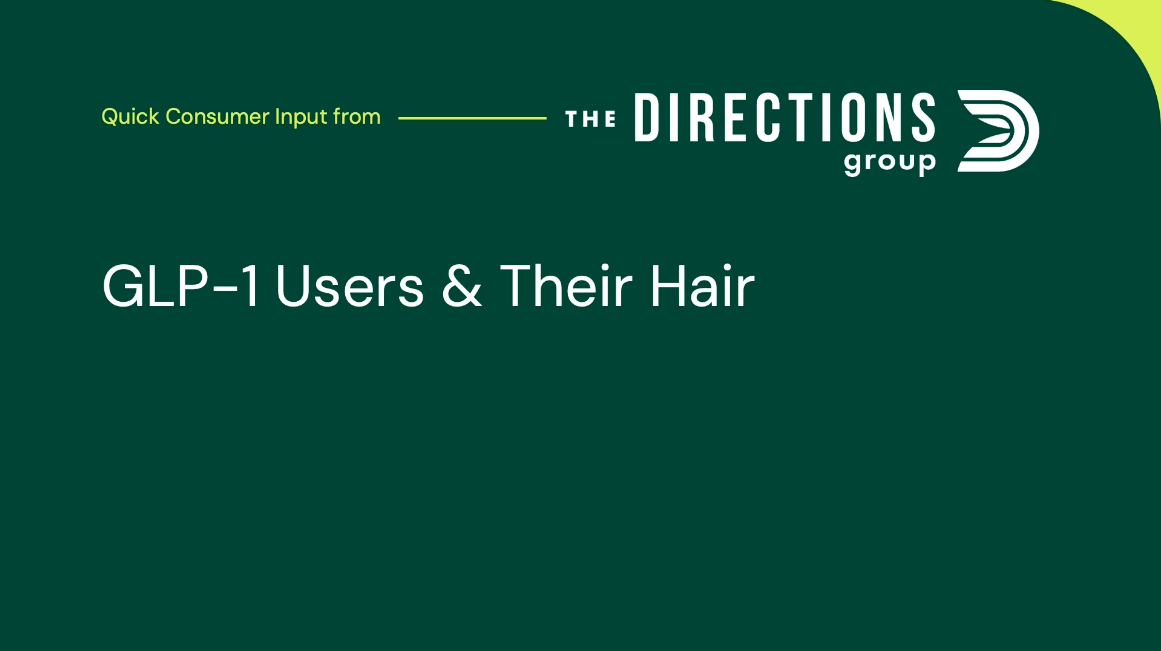GLP-1s and Hair Loss: The New Consumer Health Challenge Brands Cannot Ignore
“I’m finding clumps of hair in the shower. Will it come back?”
GLP-1 medications have transformed the health and wellness landscape, delivering dramatic weight loss for millions. But there’s a story experts and brands cannot ignore. Rapid weight changes are driving a wave of consumer anxiety as men and women across America confront sudden, unexpected hair thinning.
At least one in eight American adults has now used a GLP-1 drug1 . Online forums and communities are lighting up with urgent questions, giving brand leaders a front row seat to real consumer emotions:
“I have been on Zepbound for about a year and a half now, but I am losing quite a bit of hair all the time. Not enough to be noticeable unless my hair is wet, but it is getting very concerning. Does this happen to everyone?”
We reached out to consumers using GLP-1s to hear their thoughts firsthand. Download a video of real consumers talking about their stories.
Why Is Hair Loss So Common for GLP-1 Users?
The connection is not about the drug itself but about the body’s response to rapid weight loss and diet change.
- Telogen effluvium: Quick weight loss triggers more hair follicles to enter the resting and shedding phase, sometimes months after a change starts2.
- Reduced Appetite : GLP-1s cause reduced appetite and slow digestion, making it hard for many to maintain protein, iron, zinc, vitamin D, and other nutrients essential for strong hair3.
These effects feel devastating for people, and the emotional impact shows up across comment threads and video stories. It’s also clear they’re seeking solutions:
“Almost 6 months in. Just upped my dose to 10 mg of Zepbound. Roughly 52 pounds lost. The dreaded hair loss has started. I’m noticing clumps of my hair coming out when I shower, brush, and on my hair ties. Are there supplements or vitamins I can take to help this stop or slow down? Please help!”
The Market Opportunity Is Surging
Even before the GLP-1 boom, hair wellness was a multibillion-dollar segment. Now, new usage trends are accelerating demand.
- Global alopecia treatment: $12.5 billion (2025), projected up to $30.6 billion (2035)4
- Hair loss products: $2.22 billion (2025) up to $3.27 billion (2030)5
- Hair growth supplements: $830.6 million (2024)6 up to $1.92 billion (2030)7
- Premium segment: Products priced at $30 or more are growing three times faster than lower priced alternatives8

How Are Consumers Seeking Solutions?
- Supplements: Nutrafol, Viviscal Pro, prenatal vitamins, specialized blends with biotin, zinc, vitamin D, saw palmetto, pumpkin seed oil often purchased after peer or influencer recommendations.9 10
- Topicals: Rogaine (minoxidil), Vegamour, Nizoral, along with plant oils like rosemary and peppermint for scalp care.9 10
- Advanced or Professional Help: PRP injections, low level laser therapy (LLLT), prescription pills like finasteride.11
What Brands Should Do Next
- Build empathy and education into your messaging: Lean into the emotion around hair loss, featuring actual testimonials and video stories from GLP-1 users.
- Consider “hair care for weight transition” positioning: Products promising healthy hair during rapid change, not just “hair loss” for medical diagnoses, could resonate.
- Develop or market nutritional supplements for hair: Supplements with protein, biotin, iron, and zinc, optimized for decreased appetite and absorption, address a real and specific need.
- Offer premium solutions: Consumers are showing strong motivation to pay more for proven preventative and restorative hair care solutions.
To see and hear from real consumers about this issue, download our Voice of the Customer video.
Sources
- KFF Health Tracking Poll 2024 GLP-1 use: https://www.kff.org/health-costs/poll-finding/kff-health-tracking-poll-may-2024-the-publics-use-and-views-of-glp-1-drugs/
- Telogen Effluvium Review (PMC): https://pmc.ncbi.nlm.nih.gov/articles/PMC4606321/
- Diet and Hair Loss: Effects of Nutrient Deficiency (Nutrients Journal): https://pmc.ncbi.nlm.nih.gov/articles/PMC5315033/
- Future Market Insights – Alopecia Treatment Market (2025–2035): https://www.futuremarketinsights.com/reports/alopecia-treatment-market
- Mordor Intelligence – Hair Loss Treatment Products Market: https://www.mordorintelligence.com/industry-reports/hair-loss-treatment-products-market
- Grand View Research – Hair Growth Supplements Market: https://www.grandviewresearch.com/industry-analysis/hair-growth-supplements-market-report
- Growing Demand for Hair Health: https://finance.yahoo.com/news/growing-demand-hair-health-hair-111800730.html
- US Prestige Beauty Industry Sales Grow by 8% in the First Half: https://www.circana.com/post/us-prestige-beauty-industry-sales-grow-by-8-in-the-first-half-circana-reports
- An Overview of Commonly Used Natural Alternatives for the Treatment of Androgenetic Alopecia https://pmc.ncbi.nlm.nih.gov/articles/PMC11549889/
- Nutraceuticals for Androgenetic Alopecia https://pmc.ncbi.nlm.nih.gov/articles/PMC8944288/
- Dermatology Seattle – Combining Laser Therapy and PRP for Hair Regrowth: https://dermatologyseattle.com/effective-solutions-combining-laser-therapy-and-prp-for-hair-regrowth/
July 11, 2025
Introducing ARIN - An AI-Powered Survey Companion
It can be really difficult to get consumers to meaningfully engage with online surveys. ARIN addresses this critical industry pain point by leveraging natural conversation to uncover deeper insights than ever before.
April 24, 2025
The Directions Group and Idealyst Innovation Form Strategic Partnership
The Directions Group, a strategic insights firm, and Idealyst Innovation, a pioneering agricultural solutions company, have announced a strategic partnership designed to bring expanded intelligence services to the industry to empower agribusinesses and their farming and ranching customers.
September 19, 2024
New Study Highlights Widening Lifespan-Healthspan Gap and Implications of Evolving U.S. Health Landscape
The study, Preparing for the Tidal Wave, highlights the growing gap between lifespan and health span in the U.S., as well as six long-term trends impacting American health that will have a disproportionate influence on consumer behavior, policy, and innovation over the next decade.

Get started
Clarity in a Complex World
The problem isn’t a lack of information. The problem is the lack of clarity in the midst of more information than there has ever been.
At The Directions Group, we’re passionate about turning chaos into crystal-clear understanding that will bring you closer to your customer and drive real results for your business.
At The Directions Group, we’re passionate about turning chaos into crystal-clear understanding that will bring you closer to your customer and drive real results for your business.












